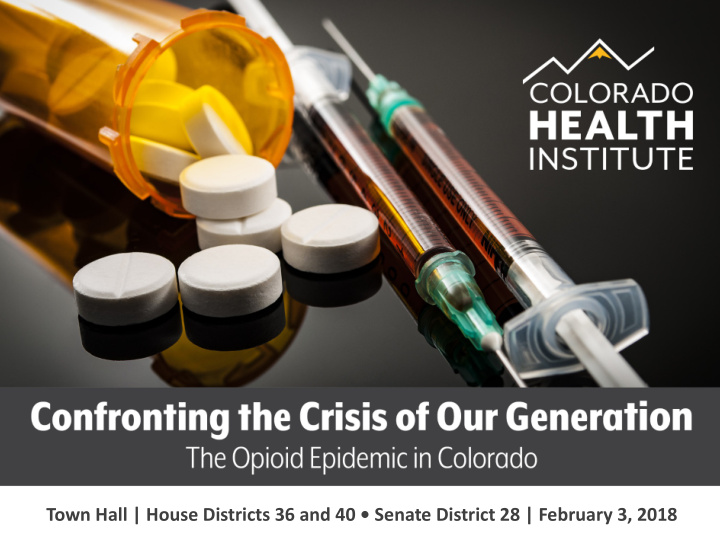



Town Hall | House Districts 36 and 40 • Senate District 28 | February 3, 2018
Key Takeaways 1. Opioid-related overdose deaths are an increasing share of drug overdose deaths. 2. Colorado is making progress on slowing prescription opioid overdoses. 3. Colorado must reduce heroin overdoses in order to reduce the drug overdose rate.
So, Why Opioids? • Colorado lost 108 people to an opioid- related overdose in 1999. • That number hit an all-time high of 504 lives lost due to an opioid in 2016.
What Are Opioids, Anyway?
Takeaway 1: Opioids make up an increasing share of drug overdose deaths
Opioids Make up an Increasing Share of Drug Poisoning Deaths Source: Colorado Department of Public Health and Environment. Rate per 100,000 people.
Demographics: Opioid Overdose Deaths Rates for heroin and prescription drugs are highest for non-Hispanic white Coloradans . Males more likely to die of a heroin overdose than females. Highest death rate for heroin in the 26 to 34 age group .
Opioid-Related Overdose Death Rates Highest in Southern Colorado, Front Range Source: Colorado Department of Public Health and Environment. Rate per 100,000 people, 2014-2016.
Takeaway 2: Colorado is making progress on slowing prescription opioid overdoses
Prescription Opioid-Related Death Rates Have Leveled Off Source: Colorado Department of Public Health and Environment. Rate per 100,000 people.
Rates of Abuse or Dependence on Prescription Opioids Have Leveled Off Source: National Survey on Drug Use and Health. Rate per 100,000 people ages 12 or older.
Why Are Prescription Opioid Death Rates Leveling Off? • Colorado Consortium for Prescription Drug Abuse Prevention • Prescription Drug Monitoring Program • Provider education and awareness • Insurance coverage
Takeaway 3: Colorado must reduce heroin overdoses
Prescription Opioid and Heroin-Related Death Rates, 1999-2016 Source: Colorado Department of Public Health and Environment. Rate per 100,000 people.
Past Year Abuse or Dependence on Prescription Opioids or Heroin, 2003-2014 Source: National Survey on Drug Use and Health. Rate per 100,000 people ages 12 or older.
Drug Poisoning Death Rates in Colorado, 1999-2016 Source: Colorado Department of Public Health and Environment. Rate per 100,000 people.
Solutions for Slowing the Epidemic • Prevention • Address underlying social factors • Fewer prescriptions • Treatment • Harm Reduction • Needle exchanges • Overdose reversal medication
Work to Do: 1 of 10 Coloradans Lack Access
A Front Line Perspective on the Opioid Epidemic and How to End It Based on Work by Don Stader, MD FACEP
ADDICTION: “If I don’t stop I know I’m going to die.” Addict. Bad person. A choice. A moral failing. Waste of time.
Addition: Brain Failure • A medical disease. • Drug seeking is compulsive. Difficult to control. Addiction is stronger than its consequences. • Relapsing & remitting. • Drugs used to: • Get High —> Feel Normal —> Not Feel Sick
Colorado Death Data 2016 • 912 People Died of Overdose • 504 Involving Opioids • Rx opioid deaths down slightly (329 in 2015, 300 in 2016) • Heroin up (160 in 2015, 228 in 2016) • Fentanyl up (41 in 2015, 49 in 2016) • Methadone up (34 in 2015, 56 in 2016) • Net Gain for All Opioids
A Colorado Tale
How to Address the Epidemic • Limit Opioids from the ED, Prescribers • Alternatives to Opioids for Painful Conditions (ALTO) • Harm Reduction (Safer Use Practices) • Treatment of Addicted Patients
Limiting Initial Supply Source: Centers for Disease Control and Prevention
Harm Reduction Principles • Science > Stigma • Understanding > Judgement • Doing Better > Status Quo
Medication-Assisted Treatment (MAT)
Where MAT is (and isn’t) in Colorado Source: Substance Abuse and Mental Health Services Administration
Current Colorado Legislation • Seven-day prescription limit (Senate Bill 22) • Expand counselor workforce (SB 24) • Supervised injection facility (SB 40) • More research and grant for screening and treatment (House Bill 1003) • Insurance payment for substance use treatment (HB 1007) • Medicaid residential treatment (HB 1136)
Teresa Manocchio Joe Hanel hanelj@coloradohealthinstitute.org manocchiot@coloradohealthinstitute.org 720.382.7079 | @CHI_Manocchio 720.382.7093 | @CHI_joehanel
Recommend
More recommend